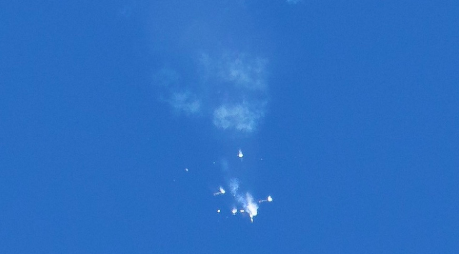Soyuz MS-10 Launch Failure
Zero-G a bit too early

One of the four strap-on boosters collided with and damaged the center booster.
October 25, 2018
Maintaining a laboratory larger than a football field is hard. Maintaining a football-field-sized laboratory that is flying 254 miles above everyone’s head at several thousand miles per hour is much harder. Maintaining a football-field-sized laboratory, 254 miles above Earth, which can only be accessed a few times a year for the low, low price of $81 million per seat is, like, crazy hard. As they now face the reality of these conundrums in full force, the astronauts aboard the ISS and employees of spaceflight firms worldwide are reeling in the wake of the failure of Soyuz mission MS-10 to the International Space Station.
MS-10 launched on Oct. 11 and aborted only two minutes in, was supposed to carry NASA Astronaut Nick Hague and Russian Cosmonaut Alexey Ovchinin, many critical supplies, and, most importantly, the Soyuz craft itself to the ISS. However, a failure with the core booster two minutes into flight forced the astronauts to eject their capsule from the rocket and land in Kazakhstan, ending the flight abruptly. Although the Russian space agency Roscosmos is still investigating the issue, it is believed that one of the four strap-on boosters, which detach just before the two-minute mark, collided with and damaged the center booster. This can be seen in the above picture of the launch as seen from the ground: three of the four boosters detach properly, forming their signature sight of a “Korolev Cross” (named for rocket designer Sergei Korolev and the four-point formation the falling boosters are supposed to make), but the fourth falls away in a different, anomalous way. This sight, along with the problem’s localization in the center booster, leads to the running theory that the anomalous booster damaged the center one, causing it to fail and force an abort.
Despite the abject failure of the launch, both Ovchinin and Hague survived their landing mostly unharmed and are answering questions and sharing the experience. However, a serious problem still exists: the current crew of the ISS can only return to Earth in one of the station’s docked Soyuz craft. The fuel in the currently orbiting Soyuz vehicles will expire before the end of the year, forcing the ISS astronauts to use or replace them soon. Roscosmos is understandably hesitant to launch any more crude Soyuz until MS-10’s failure is investigated and diagnosed, which means that it would be unlikely that new hardware could be brought up in time for the expiration date of the current craft. If no solution is brought up in time, the ISS crew will be forced to abandon the station uncrewed for months until a new round can be brought up—which, for a station as complex and fragile as the ISS, is an unacceptable time to go without maintenance. Spaceflight officials worldwide are deep in discussion about how to solve the dilemma.
